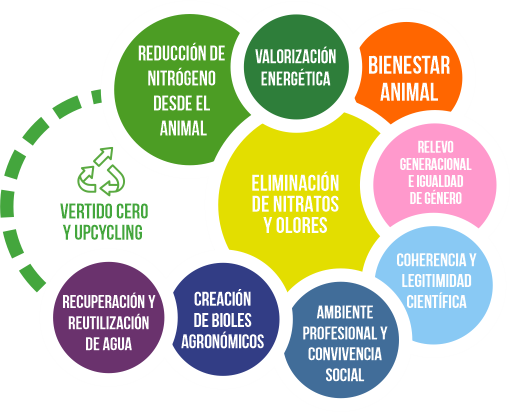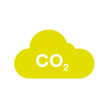
for Mar Menor
and generational change
Thinking about the challenges of livestock farming to attend to the Mar Menor in its recovery and conservation, is to think about everything that must be changed, even due to generational needs, adapting to times in which the great changes of this century also capillarize the sector of livestock farming in all its aspects, including the environmental.
The pollution of the Mar Menor, the social pressure on odors and nitrates, and all the variants of the circular economy fall on a sector that, although not in crisis, is threatened by an uncertain generational change, with industrial concentration rates of 30% accumulated in 20 years and with a challenge regarding the technology available at this time.
ASAJA Murcia poses 10 challenges that will offer important reductions and improvements to face if we want the livestock sector to overcome the great threats that loom over Campo de Cartagena and Mar Menor.

THREATS

GENERATIONAL CHANGE
Contextually, according to data from the European Commission, 57.6% of agricultural holdings are managed by farmers over 55 years old and only in 12% of them the owners are under 40 years old, half of whom are people between 35-39 years. Even in some Member States the situation is more alarming since the proportion is three farmers over 65 years of age for every farmer under 40 years of age. In general, the trend in European agriculture is worrying: there has been a significant drop in the number of farms (37% between 2005-2020), an increase in their size, greater land concentration that makes access to land and funding more complicated for young people. Furthermore, the agricultural salary in the EU is 53% lower than the average for the rest of the economic sectors, so the lack of profitability is also a significant brake on the incorporation of young people.

NITRATES IN CAMPO DE CARTAGENA
Nutrients such as nitrogen, potassium and phosphorus are essential for agricultural production. These can be supplied through commercially produced fertilizers, or through organic substances such as animal manure. However, if used in excess, nutrients can be a source of air, soil and water pollution, as well as bearers of adverse effects on both biodiversity and the climate. Agricultural activities are consumers of water and agricultural resources, but above all they are relevant to the study due to the contamination of surface and underground waters that they can cause through excrement. In the Region, 28,099 Tons N are produced annually, mainly from farms and crops. An ecological solution such as biostimulation for the slurry problem can be used to absorb ammoniacal nitrogen and can be applied to fields as a slow-release fertilizer; At the same time, it works by generating biogenic elements through local bacterial stimulation, breaking down the covalent bonds of CHONPS (new molecules) at all times.
REDUCTIONS AND IMPROVEMENTS
The 10 livestock challenges for Mar Menor aim to give a new global approach to sustainability of livestock farming, comprehensively solving the current problems, through cooperation between economic, sectoral, social and technological agents, being the ZERO (CONTAMINATION) CHALLENGE , the first one that must be overcome, so that TOGETHER we recover Mar Menor and achieve the generational change so necessary for everyone.
REDUCTION GOALS
- ODOURS
- NITRATES
- ANTIBIOTICS
- FLIES
- HEAVY METALS
- STRESS IN THE FARM
IMPROVEMENT GOALS
- WATER FOR IRRIGATION
- BIOLES
- SUPRA BIOGAS
- ANIMAL WELFARE
- UPCYCLING
- GENERATIONAL CHANGE

10 LIVESTOCK CHALLENGES

SINGEI
REMOVAL OF ODOUR AND NITRATES
The challenge focuses on eliminating ammoniacal nitrogen, odours and greenhouse gases in the pork sector of Campo de Cartagena using particulate zeolites based on BAT 2017 technology (EU), providing an 80% NH3 reduction and eliminating offensive odours from the pig farm.

SUPRA BIOGAS
Adaptation of slurry for the production of Supra-Biogas
It is necessary to reduce the ammoniacal nitrogen of the slurry to efficient levels for the generation of biomethane, eliminating levels above 50 mg/liter of NH3 (bacterial inhibition level of biomethane) through micronized zeolites and other minerals (Superior Upready Additive) , enhancing production by a 40%, and enabling it as an energy source, possible to combine with hydrogen for connection and hybridization.

PORCITRAT
Improvement through technological additives in animal food
The challenge focuses on eliminating ammoniacal nitrogen through better digestion of the fattening pig's dietary protein, improving its defense levels and reducing ammoniacal nitrogen in manure excrement by 60% and using it as a conversion improvement nutritional product (>10%).

Reducción de nitrógeno y olores de purines porcinos en Campo de Cartagena
Nuevo paradigma de gestión de purines que supera las Mejores Técnicas Disponibles (MTD) exigidas por la UE, implementando tecnología avanzada basada en complejos de calco-zeolitas en partículas, como un biorreactor pasivo en los fosos y las balsas de las granjas.

AVITRAT
Improving animal and professional welfare
Another important challenge is the elimination of ammonia nitrate (>60%) in excreta, protein digestion, excrement with a lower nitrate and volatile load, used as a product to improve feed conversion (>10%), within of the most natural environment, helping, at the same time, to improve professional coexistence.

PURINUP
Transformation of slurry into ecological biofuels

FARM ZERO
Farms 'ZERO' for Mar Menor
Farms ZERO allows the renovation of existing farms and the construction of future farms, assuming an indisputable adaptation to animal welfare and the reduction of greenhouse gas (GHG) emissions, the reuse of water, and the ZERO discharge of both solid or liquid, and minimum possible gaseous wastes, with an adequate investment that ensures livestock viability in an economic-sustainable way, both in renovation and construction.
DO YOU WANT TO KNOW MORE?
YOU CAN SEND US A MESSAGE AND WE WILL INFORM YOU IN MORE DEPTH
© 2025 | DIEZRETOS es plan estratégico y de relevo generacional ganadero de ASAJA Murcia | PRIVACY POLICY | info@diezretos.com | +34 646 720 210